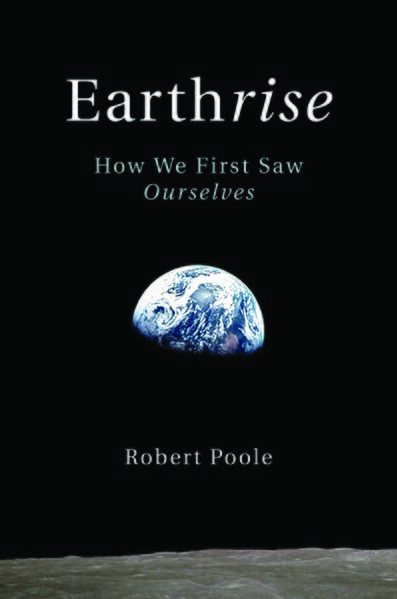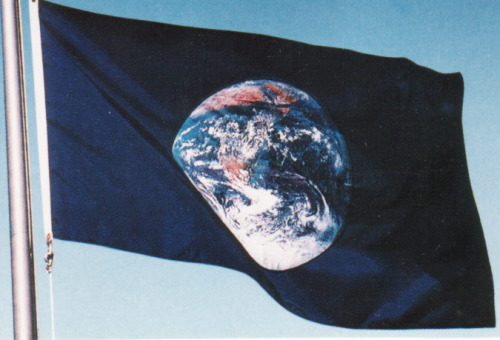File:Earthrise book cover (2008).jpg

Original file (709 × 1,070 pixels, file size: 401 KB, MIME type: image/jpeg)
Apollo 8 / Earthrise
• http://www.amazon.com/Earthrise-How-Man-First-Earth/dp/0300164033
Via Publishers Weekly
Concisely and thoughtfully, British historian Poole reveals the behind-the-scenes story of the first photographs taken of Earth from space, and how those amazing images forever changed our view of the planet, the universe and humanity. The tightly scheduled 1968 Apollo 8 mission was focused on the first lunar orbit, but "Earthrise" -- the image of a cloudy blue Earth rising over a starkly monochromatic lunar surface -- stunned everyone.
Astronaut Frank Borman called it "the most beautiful, heart-catching sight of my life." NASA, at the forefront of the "astrofuturist" movement that saw humanity's future out among the stars, was unprepared for the paradoxical reaction "Earthrise" provoked. Rather than turning people's eyes on a future in space, it refocused them on Earth. For many astronauts, says Poole, the sight "hit with the force of a religious experience," which echoed throughout the world. Fifteen months later came the first Earth Day and the start of an "eco-renaissance" devoted to preserving and protecting "Spaceship Earth." Drawing on historical reports and interviews, Poole smartly delineates the philosophical, spiritual and environmental impact of the photo that reminded humankind of the beauty and fragility of Earth.
○ ○ ○ ○ ○ ○ ○ ○ ○ ○ ○ ○
• http://www.greenpolicy360.net/w/Apollo_8
• http://en.wikipedia.org/wiki/Earthrise
○ ○ ○ ○ ○ ○ ○ ○ ○ ○ ○
SJS/GreenPolicy360 Siterunner:
With a goal of protecting life, a new environmental movement began to grow, a "Whole Earth" vision seen for the first time from space in 1968 with the iconic Apollo 8 Earthrise image and a very real 'sense' of our common responsibility for the future of the planet. Students were 'first-movers' who spoke of the existential threat of nuclear war and environmental disaster, and need to 'become' far-reaching with a new vision. Realizations grew internationally that we had created weapons capable of ending humanity and most all life of earth -- and we needed to change this nuclear doomsday threat. Protests and 'teach ins', led by students, and drawing in politicians, communities, media, news with pamphlets, books, music, art and demonstrations crossed continents with new symbols, peace symbols, environmental and eco-awareness.
The threads of teach-ins led directly to and the first Earth Day in 1970 as students expanded counterculture with action. Across the U.S., a first Earth Day of teach-ins began as a student-initiated movement on college campuses including your siterunner's college where we proposed an environment and peace action day to Senator Nelson, who we met as we organized the national Moratorium and who worked with us to make an Earth Day a national political event. At the University of Southern California, our student peace activists continued 1969's anti-war moratorium sharing a positive vision of what was needed -- environmental protection, economic and social justice, new priorities added to the nation's agenda. The work spread quickly. Earth Day's teach-ins reached out to students globally. A worldwide environmental movement became a real and growing political force...
Beginnings of the Modern Environmental Movement
🌎
File history
Click on a date/time to view the file as it appeared at that time.
| Date/Time | Thumbnail | Dimensions | User | Comment | |
|---|---|---|---|---|---|
| current | 18:33, 25 March 2015 |  | 709 × 1,070 (401 KB) | Siterunner (talk | contribs) | http://www.amazon.com/Earthrise-How-Man-First-Earth/dp/0300164033 Category:Earth Observations Category:Earth360 Category:Green Graphics Category:Overview Effect |
You cannot overwrite this file.
File usage
The following 6 pages use this file:
- Anthropocene
- Earth
- Earth Day
- Ecology Studies
- Earth Imaging
- Earth Observations
- Earth Science
- Earth Science from Space
- Earth360
- EarthPOV
- Eco-ethics
- Eco-Spirituality
- Environmental Protection
- Green Graphics
- Green Politics
- NASA
- Networking
- Overview Effect
- Peace
- Planet Citizen
- Planet Citizens
- Planet Citizens, Planet Scientists
- Whole Earth
- Youth
